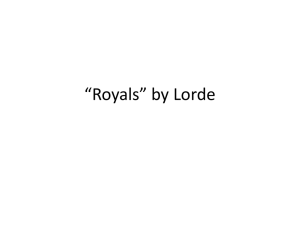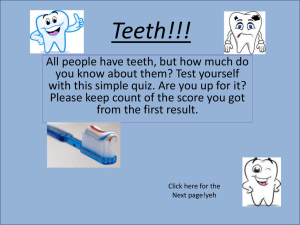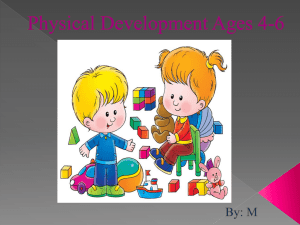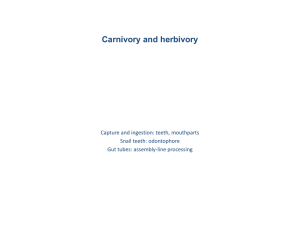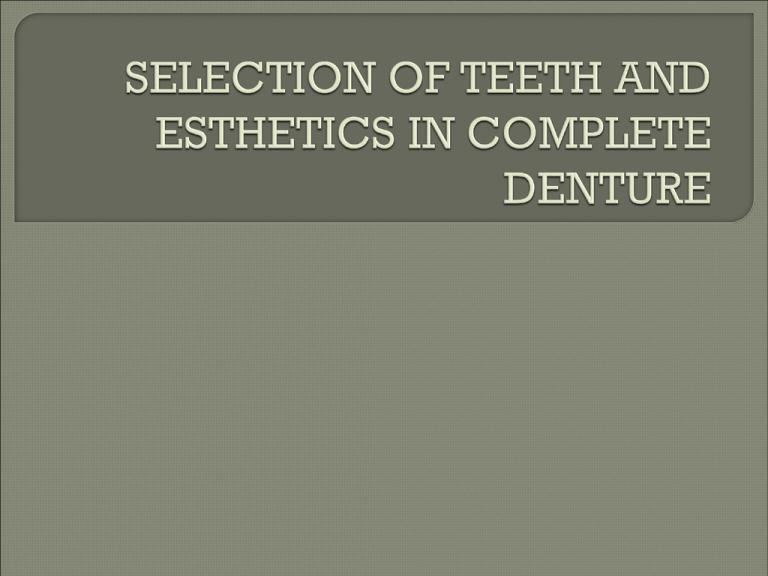
Classification of patients
1. Patients with remaining natural teeth
2. Patients who have old denture
3. Patients without remaining natural
teeth and without old denture
Objectives:
1. Esthetics
2. Masticatory function
3. Correction of speech defects
4. Preservation of the remaining tissue
and muscle tone
- Primary selection of the teeth must be
carried out at the first appointment.
Guides for the anterior teeth selection
1. Pre-extraction guides
a. Study cast
b. Photographs
c. Radiographs
d. Extracted teeth
2.Post extraction guides
- Selection of size (width and length)
a. Size of the face and head
b. Size of the contour of the maxillary arch
c. Maxillomandibular relations
i.
In class I – Normal relationship, the
teeth in one arch are compatible with
the teeth in the other arch.
ii.
In class II – The mandible is retruded
and the mandibular teeth are
frequently smaller
iii. In class III – The mandibular teeth are
frequently larger than normal
- Width of the anterior teeth
a. Bizygomatic width – The average width of the
maxillary central incisor is estimated to be 1-16 of
the bizygomatic width that is, the distance between
the cheek bones measured just in front of the ears.
Some simple devices are available from tooth
manufacturers for making this determination or
caliper may be used to measure this distance. A face
bow maybe used as caliper to make this
determination. The combined width of the six
maxillary anteriors is slightly less than one third the
bizygomatic width.
b. The width of the nose – An estimation of the position of the
apex of the upper natural canine can be found by extending
parallel lines from the lateral surface of the ala of the nose
onto the labial surface of the upper occlusion rim.
c. Corners of the mouth – The distance measured between the
two commisures (angles of the mouth ) will represent the
width of the upper six anteriors from the distal surface of the
canine to the distal surface of the other canine.
d. Canine eminence
e. Cranial circumference
f. Incisine papilla – It has been found that a transverse
line bisecting the incisive papilla will pass through
the middle of the upper canines. The necks of the
upper anterior teeth overlap the anterior ridge by 12 mm cervically, and the incisive edges of the
centrals must show below the relaxed lip by 1-2 mm
in a young person and less than half that amount in
an elderly patient.
1. The vertical distance between the ridges – Is
determined by the available space between the
existing ridges.
2. The lips
3. Vertical overlap
4.
The length width ration of the patient’s
face.
Length of face
Width of face
=
Length of tooth
Width of tooth
Selection of the form
- Guides for selecting the form of anterior
teeth.
- Shape of the arch.
Tooth form in relation to arch form
- Shape of the face
Selection of shade
- Color and shade of tooth
N.B. The shade consist of:
a.
Hue i.e specific color
b.
Saturation i.e. amount of color per unit
area.
c.
Translucency i.e ability of color to
permit light to pas through it.
Patients age – With age, darker, while
lighter teeth are suitable for young
patients.
Patients complexion—light teeth for fair
skin, blue eyes, dark teeth usually for
dark skin and black eyes.
The following facts are true for nearly all
natural teeth:
a. The neck of the tooth has a more
pronounced color than the incisive edge.
b. The incisive edge if not worn, is more
transluscent that the body of the tooth
and is usually of a bluish shade
(composed entirely of enamel)
c.The upper central incisors are lightest teeth in
the mouth followed by the laterals and canines.
Posterior teeth are usually uniform in color.
d.
Teeth darken slightly with age.
- Aid for selecting the shade
Shade guides – The shade guide tooth should be
moistened and selection made in the normal
light.
a.Outside the mouth along the side of the nose.
b.
Under the lip with the incisal edge exposed
c.Under the lip with only the cervical end covered
and the mouth open.
The color should be matched with the skin of the
cheeks.
General consideration for selection of anterior teeth
1.Sex
a. Females – All teeth are more curved, rounded line
and point angles, the teeth more ovoid or tapeing
than square.
b.Male – The teeth are larger with sharp line and point
angles, the teeth more square than ovoid or tapeing.
2.Age
3.Personality
Posterior teeth selection – Posterior teeth should
have a small bucco-lingual width to keep forces
on the supporting structure to a minimum.
The mesiodistal measurements of the upper
posterior teeth is taken from the distal surface of
the canine to the prominence of the tuberosity.
The total mesiodistal width of the four posterior
teeth is often used as a mould number. The lower
posterior teeth should not extend posterior to
the mesial border of the retromolar pad.
It is advisable to select upper posterior
teeth as long as possible so that the
premolars will be esthically in harmony
with the canine. Actually there are long,
medium and short posterior teeth.
Anatomic teeth
- Balanced occlusion
- Young healthy patients
- Good ridges
Non anatomic form or monoplane teeth
- Flat occlusal surfaces (without cusp)
- Not function efficiently
- Balanced occlusion
- Less destructive force to the tissues
- Old patients having poor ridges with poor
neuromuscular control.
Advantages of anatomic teeth.
1. Esthetically acceptable
2. More efficient in cutting of food,
thereby reducing forces that are
directed to the supporting structures
during masticatory movement.
3. They can be arranged in balances
occlusion
Disadvantages of anatomic teeth.
1.
It is mandatory to use an adjustable
articulator.
2.
Eccentric records must be done for
articulator adjustments
3.
Clinical remount is essential to adjust
the occlusion after denture settling.
4.
Balanced occlusion lost when settling
occurs.
5.
More horizontal forces during functions.
6.
Frequent relining, Fast bone resorption
Advantages of non anatomic teeth
1.Comfortable
2.The allow greater range of movements which is
necessary in patients with mal-related jaws (as
those with Para functional jaw habits or wide
mandibular movement)
3.Non anatomic teeth exerts less horizontal or
torquing forces, so they are used with flat ridge
cases.
4.Centric record only is needed
5.When the neuromuscular control are so
uncoordinated, the jaw records are not
repeatable
Disadvantages of non anatomic teeth.
1. They are of unnatural look
2. Less cutting efficiency
3. The flat teeth occlude in two
dimensions only, but the mandible has 3
dimension movements.
Porcelain teeth
- Wear is clinically insignificant over a long period of
time
- No significant loss vertical dimension
- Allow for the total rebasing procedures
- Maintain communicating efficiency
- Difficult to grind and fit into a close inter-ridge space
- Cause dangerous abrasion to opposing gold crown
and natural teeth.
- Have a sharp impact sound
- Will not bond to the base material except with
mechanical means. The anterior porcelain teeth have
pins at the back, while the posteriors have holes.
Acrylic resin teeth.
- Wear is clinically significant
- Loss of occlusal vertical dimension due to wear.
- Occlusal surface is altered by wear.
- Do not chip, and have softer impact sounds
- Easy to adjust and polish
- Easy to grind into close inter ridge space
- Will bond to base material by chemical union.
- Minimal wear to opposing natural teeth and gold
crowns. This is a definite indication for their use
Acrylic teeth are used in the following
situations
1. Limited inter-arch distance
2. Maxillary single denture against
natural dentition.
3. Maxillary single denture opposing
partial denture
4. Opposing natural teeth with gold
occlusal surfaces
Upper and lower posterior teeth can be
- Both porcelain
- Both acrylic
- A combination of porcelain and acrylic resin teeth
on opposing dentures can be used. It softens the
impact sounds, reduces friction and eliminates
chipping.
- Upper posterior porcelain anatomic teeth with non
anatomic lower resin teeth
- Upper and lower posterior acrylic teeth with upper
anterior porcelain teeth is contraindicated because
the resin teeth will wear rapidly resulting in occlusal
destruction of the underlying tissues.



